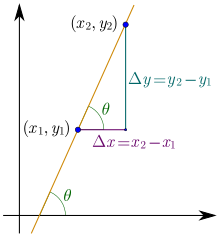
Back ኩርባ Amharic ميل المستقيم Arabic طيوح (ماط) ARY Bucaq əmsalı Azerbaijani Диференчно частно Bulgarian ঢাল Bengali/Bangla Pendent (matemàtiques) Catalan لێژی CKB Směrnice přímky Czech Тайлăм коэффициенчĕ CV

In mathematics, the slope or gradient of a line is a number that describes the direction of the line on a plane.[1] Often denoted by the letter m, slope is calculated as the ratio of the vertical change to the horizontal change ("rise over run") between two distinct points on the line, giving the same number for any choice of points.
The line may be physical – as set by a road surveyor, pictorial as in a diagram of a road or roof, or abstract. An application of the mathematical concept is found in the grade or gradient in geography and civil engineering.
The steepness, incline, or grade of a line is the absolute value of its slope: greater absolute value indicates a steeper line. The line trend is defined as follows:
- An "increasing" or "ascending" line goes up from left to right and has positive slope: .
- A "decreasing" or "descending" line goes down from left to right and has negative slope: .
Special directions are:
- A "(square) diagonal" line has unit slope:
- A "horizontal" line (the graph of a constant function) has zero slope: .
- A "vertical" line has undefined or infinite slope (see below).
If two points of a road have altitudes y1 and y2, the rise is the difference (y2 − y1) = Δy. Neglecting the Earth's curvature, if the two points have horizontal distance x1 and x2 from a fixed point, the run is (x2 − x1) = Δx. The slope between the two points is the difference ratio:
Through trigonometry, the slope m of a line is related to its angle of inclination θ by the tangent function
Thus, a 45° rising line has slope m = +1, and a 45° falling line has slope m = −1.
Generalizing this, differential calculus defines the slope of a plane curve at a point as the slope of its tangent line at that point. When the curve is approximated by a series of points, the slope of the curve may be approximated by the slope of the secant line between two nearby points. When the curve is given as the graph of an algebraic expression, calculus gives formulas for the slope at each point. Slope is thus one of the central ideas of calculus and its applications to design.
- ^ Clapham, C.; Nicholson, J. (2009). "Oxford Concise Dictionary of Mathematics, Gradient" (PDF). Addison-Wesley. p. 348. Archived from the original (PDF) on 29 October 2013. Retrieved 1 September 2013.






